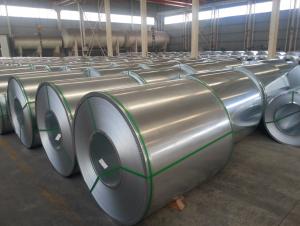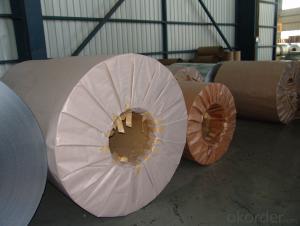Galvanized Steel Coils/ Strips Hot Sales
- Loading Port:
- Shanghai
- Payment Terms:
- TT OR LC
- Min Order Qty:
- 30 m.t.
- Supply Capability:
- 10000 m.t./month
OKorder Service Pledge
OKorder Financial Service
You Might Also Like
Basic Info.
Model NO.:SGCC, DX51D
Surface Treatment:Galvanized
Certification:SGS
Technique:Cold Rolled
Standard:ASTM, JIS, GB, DIN
Application:Container Plate
Edge:Slit edge
Steel Grade:Q195
Width:10-1250mm
Coil Weight:3-5tons
Thickness:0.18-2.0mm
Export Markets:Global
Additional Info.
Packing:Stanadrd Sea Worth
Standard:SGS
Origin:China
HS Code:72104900
Production Capacity:4000 Tons/Month
Product Description
Cold rolled steel coil/ band / strip / strap/ tape
Standard GB ASTM BS JIS DIN
Material Q195 Q235 Q345 SS400 ST 37 SAE1008 A36
Size: 0.11mm - 3.0mm
Width as your requirement from 10mm-1500mm
Package: Stanadrd sea worth or as your requirement
Coil weight: As your requirement from 50-7000kg
Quality warranty: Any third party inspection is accepted.
Quality Certificate: MTC Mill orioginal and others as your requirement.
Commodity | Galvanized Steel Coils |
Thickness | 0.12mm-5mm |
Width | 600-1500mm |
Zinc mass | 40-275 gsm |
Coil Weight | 3-8 tons |
Standard | ASTM, AISI, GB, JIS, DIN |
Grade | Q195-Q345, SGCC, SPCC, SPHC, DC51D, DX51D, DX52D, SS grade 33-80, DX 54D |
Spangle | Big Spangle, Small Spangle, Regular Spangle, Zero Spangle |
Payment | T/T, L/C |
MOQ | 30 tons |
Packaging | Seaworthy standard packaging or as customed |
Delivery | 10-20 days after receiving the prepayment |
- Q: Can steel coils be coated with QR codes?
- Yes, steel coils can be coated with QR codes. QR codes can be printed or engraved onto the surface of the steel coils, allowing for easy scanning and identification of the coils.
- Q: Steel is no doubt a better constructin material but it is only in practice in developed country.i would like that we should high lights the benifits and negatives of steel to make the steel more clear as a construction material.Hope some expert to address this topicMD
- Steel Structure considered as the most efficient and fast in completion of any project, specially the high rise buildings, also the logistics during construction is less complicated than the normal methods, Steel Structure has so many advantages vs the disadvantages, and highly recommended for commercial buildings
- Q: Hi my dad bought a stain steel refridg. yesterday, and we went to clean it and it looks all streaky and gets finger prints and stuff on it too easily we used mr clean multisurface cleaner and it didnt work to well is there a certain type of cleaner we are supposed to use?
- I use water but do it in sections so wipe then with a dry cloth dry then with another dry cloth dry again, then continue this and you will get ride of all streaks you could try window cleaner (windex) spray on then wipe with paper towels then go over with a paper towel again or a dry tea towel; I like using the cotton tea towels as I find the other tea towel (like towels) leave fluff and that annoys me big time as I can't handle streaks Good luck as it can drive you up the wall try and train every one to open and close the door by the handle only not closing the door by putting there fingers on the door; easier said than done.
- Q: I have a necklace that has a pendent made out of stainless steel. The pendent is connected by a cord, not chain, that I can take on and off; so, I leave it on all the time. It has gotten pretty tarnished because of that.
- steel jewelry Daily care? Just need a soft cloth just fine. Or you can use toothpaste to clean the stailess steel jewelry.
- Q: What are the surface treatments for steel coils?
- Some common surface treatments for steel coils include galvanizing, painting, and coating. These treatments are applied to protect the steel from corrosion, improve its appearance, and enhance its durability.
- Q: How are steel coils handled during transportation to prevent damage?
- Steel coils are typically handled with great care during transportation to prevent damage. They are usually secured with steel bands or straps to keep them in place and prevent them from shifting or rolling. Additionally, they are often placed on specialized transportation equipment, such as flatbed trailers or coil carriers, that have built-in supports to hold the coils securely. These measures help ensure that the coils remain stable and protected throughout the transportation process, minimizing the risk of damage.
- Q: I know that mild steel is more brittle than cast iron....but that is all.......please help??Thank you in advance......Ruby:D
- This Site Might Help You. RE: what is the diiferent in composition between mild steel and cast iron? I know that mild steel is more brittle than cast iron....but that is all.......please help? Thank you in advance......Ruby :D
- Q: I have a set of Stainless steel pots and pans. Everything is sticks to them. What must I do so things don't stick?
- First, they must be absolutely shiny, clean. Use a scouring pad in circular motions to make them as smooth as possible, then use Non-stick spray, but read the label, some oil sprays contain water and they will stick every time. Spray with canola or pour canola in the pan and warm it up before putting in the food. For flavor you can mix the canola with some olive oil or butter, but don't overheat or they will smoke and burn. For frying pancakes or eggs, the best choice is a teflon coated pan, use an oil spray and medium heat only.
- Q: Steel resist tension. Then why we provide steel in compression zone ?
- There are several reasons to add compression steel. Keep in mind, supported steel (meaning it can't buckle) resists compression as well. Compression steel helps reduce long term deflections. Concrete creeps under sustained loads. Steel lessens the compression, meaning less sustained compressive stress to cause creep deflection. It makes members more ductile. Since the steel takes some of the compressive stress, the compression block depth is reduced, increasing the strain in the tension steel at failure, resulting in more ductile behavior (the moment at first yield remains largely the same with compression steel added, but the increase in capacity after yield is significant). Compression steel insures that the tension steel yields before the concrete crushes, meaning it helps change the failure mode to tension controlled. It makes beams easier to construct. With bars in the top and bottom, you have longitudinal reinforcement in all 4 corners of the shear stirrups to keep them in place when pouring the concrete. Also, for continuous members, its often easier to run your negative moment steel the full length of the beam rather than trying to cut it off in the positive moment regions. Serviceability concerns. You're going to end up putting steel in that region anyway to for temperature and shrinkage.
- Q: How are steel coils tested for tensile strength?
- Steel coils are typically tested for tensile strength using a method called tensile testing. This involves subjecting a sample of the steel coil to a controlled pulling force until it breaks. The force required to break the sample is then measured, providing an accurate measure of the steel's tensile strength.
Send your message to us
Galvanized Steel Coils/ Strips Hot Sales
- Loading Port:
- Shanghai
- Payment Terms:
- TT OR LC
- Min Order Qty:
- 30 m.t.
- Supply Capability:
- 10000 m.t./month
OKorder Service Pledge
OKorder Financial Service
Similar products
Hot products
Hot Searches
Related keywords


























